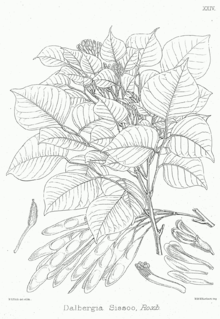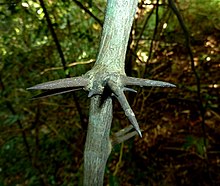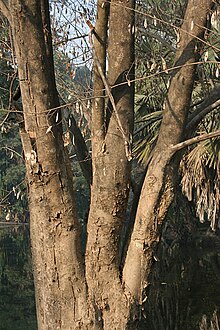

Dalbergia is a large genus of small to medium-size trees, shrubs and lianas in the pea family, Fabaceae, subfamily Faboideae. It was recently assigned to the informal monophyletic Dalbergia clade (or tribe): the Dalbergieae.[2][3][4] The genus has a wide distribution, native to the tropical regions of Central and South America, Africa, Madagascar and southern Asia.
| Dalbergia | |
|---|---|
 | |
| Sissoo or Indian rosewood (Dalbergia sissoo) | |
| Scientific classification | |
| Domain: | Eukaryota |
| Kingdom: | Plantae |
| Clade: | Tracheophytes |
| Clade: | Angiosperms |
| Clade: | Eudicots |
| Clade: | Rosids |
| Order: | Fabales |
| Family: | Fabaceae |
| Subfamily: | Faboideae |
| Tribe: | Dalbergieae |
| Genus: | Dalbergia L.f.[1] |
| Species | |
275; see text. | |
| Synonyms[1] | |
| |




A fossil †Dalbergia phleboptera seed pod has been found in a Chattian deposit, in the municipality of Aix-en-Provence in France.[5] Fossils of †Dalbergia nostratum have been found in rhyodacite tuff of Lower Miocene age in Southern Slovakia near the town of Lučenec.[6] Fossil seed pods of †Dalbergia mecsekense have been found in a Sarmatian deposit in Hungary.[7] †Dalbergia lucida fossils have been described from the Xiaolongtan Formation of late Miocene age in Kaiyuan County, Yunnan Province, China.[8]
Many species of Dalbergia are important timber trees, valued for their decorative and often fragrant wood, rich in aromatic oils. The most famous of these are the rosewoods, so-named because of the smell of the timber when cut, but several other valuable woods are yielded by the genus.
Species such as Dalbergia nigra known as Rio, Bahia, Brazilian rosewood, palisander de Rio Grande, or jacaranda and Dalbergia latifolia known as (East) Indian Rosewood or Sonokeling have been heavily used in furniture given their colour and grain. Several East Asian species are important materials in traditional Chinese furniture.
The (Brazilian) tulipwood (D. decipularis) is cream coloured with red or salmon stripes. It is most often used in crossbanding and other veneers; it should not be confused with the 'tulipwood' of the American tulip tree Liriodendron tulipifera, used in inexpensive cabinetwork.
The similarly used (but purple with darker stripes), and also Brazilian, kingwood is yielded by D. cearensis. Both are smallish to medium-sized trees, to 10 m. Another notable timber is cocobolo, mainly from D. retusa, a Central American timber with spectacular decorative orange red figure on freshly cut surfaces which quickly fades in air to more subdued tones and hues.
Dalbergia sissoo (Indian rosewood) is primarily used for furniture in northern India. Its export is highly regulated due to recent high rates of tree death due to unknown causes.[clarification needed][citation needed] Dalbergia sissoo has historically been the primary rosewood species of northern India. This wood is strong and tough, with color golden to dark brown. It is extremely durable and handsome, and it maintains its shape well. It can be easily seasoned. It is difficult to work, but it takes a fine polish. It is used for high quality furniture, plywoods, bridge piles, sporting goods, and railway sleepers. It is a very good material for decorative work and carvings. Its density is 770 kg/m³.
African blackwood (D. melanoxylon) is an intensely black wood in demand for making woodwind musical instruments.
Dalbergia species are used as food plants by the larvae of some Lepidoptera species including Bucculatrix mendax which feeds exclusively on Dalbergia sissoo.
The Dalbergia species are notorious for causing allergic reactions due to the presence of sensitizing quinones in the wood.
All Dalbergia species are protected under the Convention on International Trade in Endangered Species of Wild Fauna and Flora (CITES) [9]. All but Dalbergia nigra are listed in Appendix II, with D.nigra listed in Appendix I.
Dalbergia comprises the following species:[10][11]
联系客服